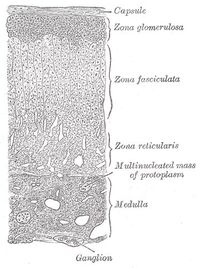Assessment |
Biopsychology |
Comparative |
Cognitive |
Developmental |
Language |
Individual differences |
Personality |
Philosophy |
Social |
Methods |
Statistics |
Clinical |
Educational |
Industrial |
Professional items |
World psychology |
Biological: Behavioural genetics · Evolutionary psychology · Neuroanatomy · Neurochemistry · Neuroendocrinology · Neuroscience · Psychoneuroimmunology · Physiological Psychology · Psychopharmacology (Index, Outline)

Layers of cortex.
Situated along the perimeter of the adrenal gland, the adrenal cortex mediates the stress response through the production of mineralocorticoids and glucocorticoids, including aldosterone and cortisol respectively. It is also a secondary site of androgen synthesis.
Hormones
All adrenocortical hormones are synthesised from cholesterol. Cholesterol is transported into the inner mitochondrial membrane by steroidogenic acute regulatory protein (StAR), where it is converted into pregnenolone by the enzyme CYP11A. Accordingly, production of hormones in all three layers of the adrenal cortex is limited by the transportation of cholesterol into the mitochondria and by its conversion into pregnenolone. Pregnenolone can be either dehydrogenated to progesterone or hydroxylated to 17-alpha-hydroxypregnenolone. The steps up to this point occur in many steroid-producing tissues. Subsequent steps, however, only occur in the adrenal cortex.
- Progesterone ->(hydroxylation at C21)-> Deoxycorticosterone ->(two further hydroxylations)-> Aldosterone
- Progesterone -> (hydroxylation at C17)-> 17-alpha-hydroxyprogesterone ->(hydroxylation)-> Deoxycortisol ->(hydroxylation)-> Cortisol
Layers
The cortex can be divided into three distinct layers of tissue based on their organization. The most superficial cortical layer is the zona glomerulosa, which produces mineralocorticoids (eg, aldosterone). Beneath the glomerulosa are the zonae fasciculata and reticularis, which produce glucocorticoids (eg, cortisol) and weak androgens (eg, dehydroepiandrosterone).
The layers of the cortex can be remembered with the mnemonic GFR: G - glomerulosa, F - fasciculata, R - reticularis. Another mnemonic that is used is Go Find Rex, Make Good Sex: G - glomerulosa, F - fasciculata, R - reticularis, M - mineralcorticoids, G - glucocorticoids, S - sex hormones.
Zona glomerulosa
The zona glomerulosa is the most superficial layer of the adrenal cortex, lying directly beneath the adrenal gland's capsule. Its cells are ovoid in shape and are arranged in clusters or arches (glomus is Latin for "ball").
In response to increased potassium levels or decreased blood flow to the kidneys, cells of the zona glomerulosa secrete the mineralocorticoid aldosterone into the blood as part of the renin-angiotensin system. Aldosterone regulates the body's concentration of electrolytes, primarily sodium and potassium, by acting on the distal convoluted tubule of kidney nephrons to:
- increase sodium reabsorption
- increase potassium excretion
- increase water reabsorption through osmosis
Zona fasciculata
Cells of the zona fasciculata sit directly beneath the zona glomerulosa and are organized in bundles (or fascicles). The zona chiefly produces glucocorticoids (eg, cortisol) and a small amount of weak androgens (eg, dehydroepiandrosterone).
Cortical cells responsible for the production of glucocorticoids are the primary effectors of adrenocorticotropic hormone (ACTH). The hypothalamus secretes corticotropin-releasing hormone which stimulates the anterior pituitary gland to release ACTH; another hypothalamic hormone, arginine vasopressin augments ACTH secretion, with the two together stimulating larger release than ACTH in isolation. ACTH acts on the adrenal cortex to stimulate the release of glucocorticoids. This three-organ endocrine system is commonly called the hypothalamic-pituitary-adrenal axis.
The primary glucocorticoid released by the adrenal gland is cortisol. Upon binding to its target, cortisol enhances metabolism in several ways:
- stimulating the release of amino acids from the body
- stimulating lipolysis, the breakdown of fat
- stimulating gluconeogenesis, the production of glucose from newly-released amino acids and lipids
- conserving glucose by inhibiting uptake into muscle and fat cells
In addition to glucocorticoid production, the fasciculata is a secondary source of androgens such as testosterone, dihydrotestosterone (DHT), androstenedione, and dehydroepiandrosterone (DHEA). These enhance muscle mass, stimulate cell growth, and aid in the development of the secondary sex characteristics.
Zona reticularis
The innermost layer of the adrenal cortex, the zona reticularis sits beneath the zona fasciculata and atop the adrenal medulla. Its cells are arranged in a network of cords (a reticulum) and have the same functions as cells of the zona fasciculata. It is thought that the zona reticularis is the principal source of glucocorticoids and adrenal androgens, with the zona fasciculata activating only after prolonged stimulation.
Pathology
- Adrenal insufficiency (e.g. due to Addison's disease)
- Cushing's syndrome
- Congenital adrenal hyperplasia
- Conn's syndrome
See also
| This page uses Creative Commons Licensed content from Wikipedia (view authors). |